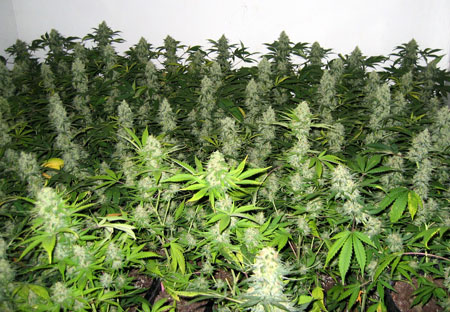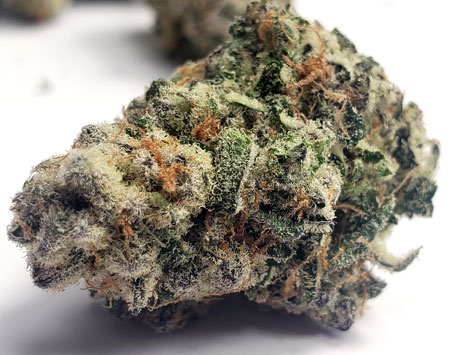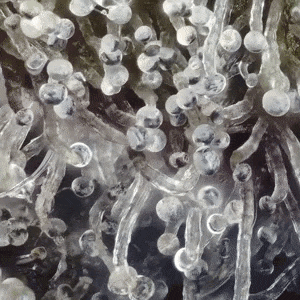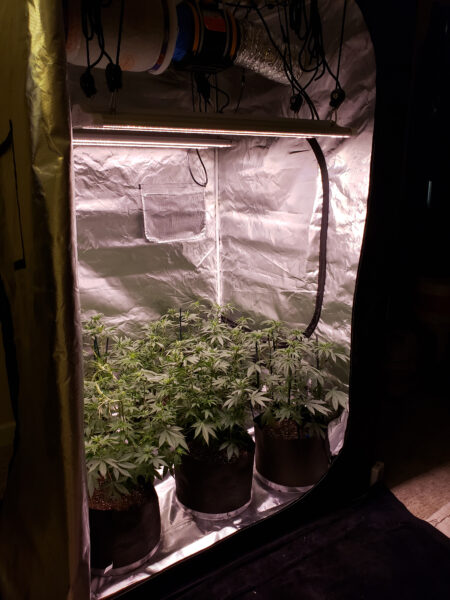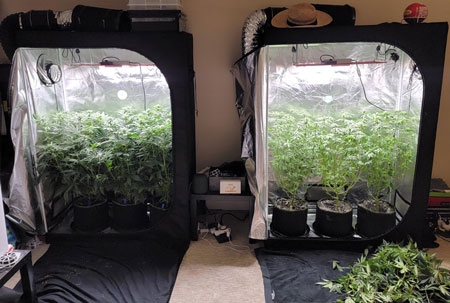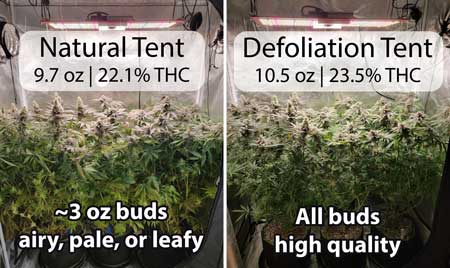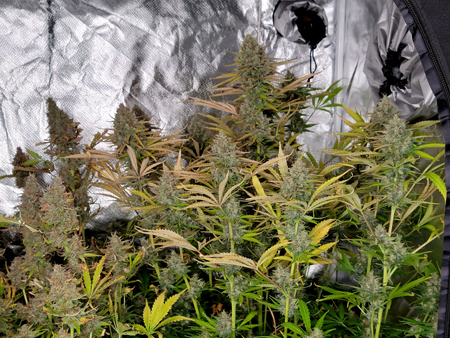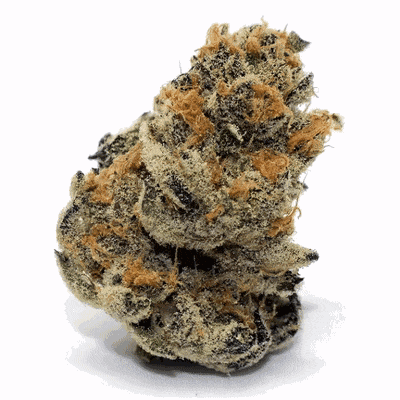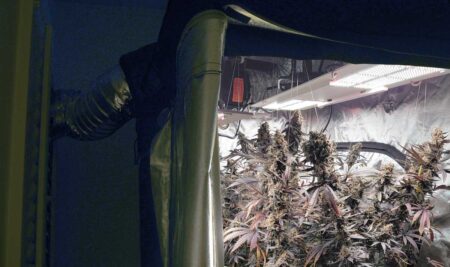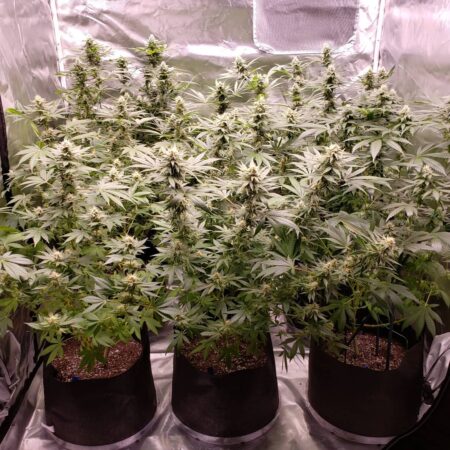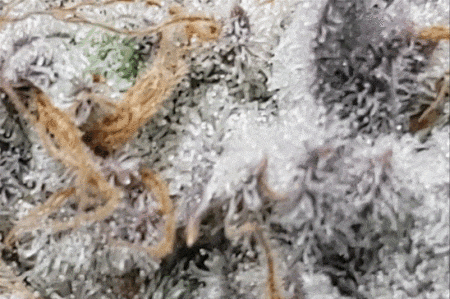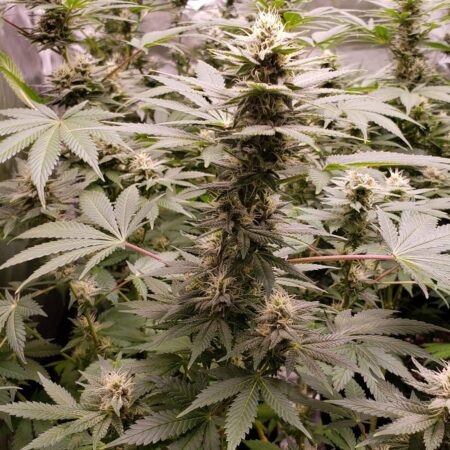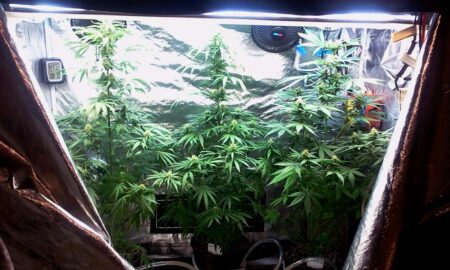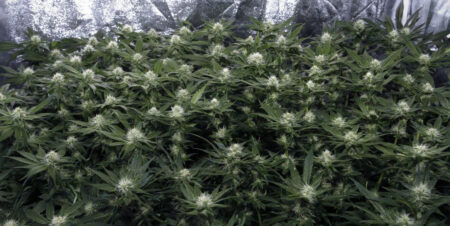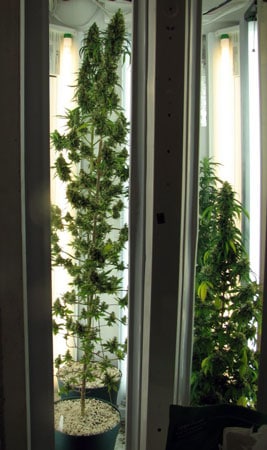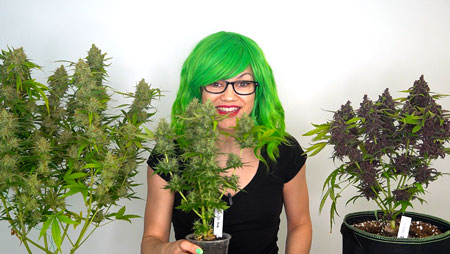by Nebula Haze
Calling all cannabis growers! Do you also seek to improve your cannabis yields, potency, and overall bud quality based on the latest knowledge?
As a passionate and curious home grower, I embarked on a series of ground-breaking side-by-side experiments to test out long-standing theories in the cannabis home cultivation community. The result? Prepare to get your notions questioned. Not only did my findings surprise me, I sought out experienced commercial growers and learned their personal tests confirmed these surprising results, too.
Together, we’ve unlocked a wealth of new knowledge and growing skills for all growers to benefit from. Get ready to revolutionize your cannabis cultivation game (bigger yields, tighter buds, more terpenes, and higher THC levels) with the top 7 most recent lessons I’ve learned about cannabis cultivation going into 2024.
1.) More Light = More THC (Up to a Point)
Get More THC with Increased Light Intensity: It’s a well-known fact among growers that more light typically boosts cannabis yields, or the total amount of bud produced. However, our recent experiments and lab testing reveal another fascinating correlation: the intensity of light a cannabis bud receives directly influences its THC content. For example, even on the same plant and the same branch, the buds which receive higher light intensity tested with higher THC at the lab than their fellow buds that were hidden under a leaf during development, or located further from the grow light. For home cannabis growers who aim to elevate their bud potency, prioritizing strong direct light exposure to buds is key.
Focus on providing high light levels directly to cannabis buds during the flowering stage to maximize THC production.
Evolution of a Theory: Since my early days of growing in 2008, a hotly debated theory suggested that increasing light levels during the flowering stage could boost THC percentages in buds. Some growers speculated that THC served as a defense mechanism for the plant against sunlight, while others doubted its impact. Regardless of why the cannabis reacts to strong light with more THC, this once controversial theory is now pretty well proven to be true.
2024 Insight: There’s a clear correlation between light intensity and THC production. Our lab tests confirmed it, and several commercial growers showed us that their tests also echoed this finding. Even within the same plant, buds that receive less light exhibit lower THC levels compared to those that developed under more intense light. Make sure all buds on a cannabis plant are exposed to strong, direct light in order to maximize THC levels at harvest.
5 Practical Tips for Home Growers to Increase THC:
- Maximize Light Exposure: Keep your grow lights as close as possible to the plants without causing light stress (which may bleach leaves or cause brown spots). Discover examples of excellent grow light setups here.
- Choose Powerful Grow Lighting: Use the most powerful light your grow space can accommodate. For most cannabis growers, LED grow lights are your best choice to maximize light to your buds. The only exception is if you’re growing in a cool grow space that regularly stays under 73°F/23°C (for example a cellar), because cannabis plants grow poorly in a cool space with LEDs. If it’s chilly, you will get better yields and higher THC buds using an HPS grow light because HPS lights keep plants warm.
- Maintain Optimal Nutrients and Environment: A healthy plant is more resilient and can handle higher light levels.
- Be mindful of giving the right amount of nutrients, maintaining proper pH levels at the roots to prevent nutrient deficiencies, and environmental factors like temperature and humidity. These can influence your plant’s response to light and overall THC production.
- Healthy, happy plants can thrive under higher light levels. That means that proper care and environmental management are crucial to maximize light and therefore THC yield.
- Train Plant Shape for Even Light Distribution: Bend and tie down branches to shape your cannabis plants flat and wide during the vegetative stage. This ensures uniform distance from the light for all buds during flowering.
- Expose Buds in the Flowering Stage: After cannabis buds start forming, make sure they are exposed to direct light. If buds are being covered by a leaf, tuck the leaf away, or remove if if it can’t be tucked. This free and easy technique helps get the most light to buds as possible.
2.) The Surprising Effects of Red on THC and Yields
This lesson is somewhat related to the last one: Spectrum of light affects THC percentage and yields. More red is often associated with higher THC, though too much red reduces overall yields.
In the world of cannabis cultivation, the impact of light spectrum on THC percentage and yields is a fascinating topic. My own side-by-side experiments, backed by insights from a commercial grower at a recent cannabis conference, have highlighted a noteworthy pattern: more red in the light spectrum often correlates with higher THC levels. However, this comes with a caveat; an excess of red can actually decrease overall bud production and yields.
Optimizing red light in the spectrum when growing cannabis can increase the amount of THC in buds.
Evolution of a Theory: It’s well established that red light can increase yields in the flowering stage compared to more blue light, but it is much less well known that the presence of a lot of red could also increase THC production to a point. However, there is a tradeoff. Too much red causes THC levels to stay high, but it begins reducing yields. So for example, if you try to grow cannabis under just red light, the buds will stay undersized and underdeveloped. Balance is key.
2024 Insight: For max THC, always use a red spectrum light, but don’t use lights that go crazy with red spectrum. Modern “red spectrum” LED grow lights, or red-tinted bulb lights like HPS, typically contain more than enough red for excellent bud production. However, if you grow with “vegetative” or blue-tinted grow lights during the crucial flowering stage, you may be unintentionally sabotaging your THC production.
Practical Tips for Home Cannabis Growers:
- Use a red-spectrum light in the flowering stage.
- Note: A spectrum with a lot of blue light is better in the vegetative stage because it tends to keep plants short and squat. Red light in the vegetative stage makes plants tend to grow tall and stretchy, which is not a desirable shape most of the time because it’s harder to get the same amount of light to all buds.
- In other words, most home growers will get the best growth patterns by using a light with more blue in the vegetative stage, and a light with more red in the flowering/budding stage.
- Don’t go overboard adding red or it will reduce yields and plants may start to grow strangely with unusual growth patterns. Plenty of of red is good, but there is too much of a good thing.
- Recommended grow light: HLG 350R – A lot of red combined with incredible brightness results in maximum yields and THC per watt. This light was developed over several years of testing on cannabis plants to find the optimal configuration.
- very powerful 350W LED grow light, best for advanced growers as it pushes plants to their full potential (i.e. works plants hard).
- can be used in a 2’x4′ space, but also produces excellent results in a bigger 4’x4′ grow space.
- harvest up to 1 lb of potent buds when cannabis plants are properly cared for.
3.) Strategic Defoliation Can Increase Yields, Bud Density, and THC Levels
Defoliation works to increase yields, bud density, and THC percentage of cannabis buds when used strategically in the flowering stage. Yes, simply using this free, easy technique can increase both the amount and quality of your weed at harvest.
Strategic defoliation in the flowering stage increases cannabis yields, bud density, and THC levels.
Evolution of a Theory: I learned about cannabis flowering stage defoliation as a way to increase yields in the early 2010s through a random forum post. I gave it a try according to his directions and was pretty blown away how it increased my cannabis yields and overall bud quality/density compared to no defoliation. When my partner Sirius and I reported our results on GrowWeedEasy.com, many growers literally told us we were lying because “that doesn’t make any sense”. More light to the leaves should equal more yields, right? We didn’t understand why it worked, but we knew it worked. By the mid-2015s enough growers had tried it that it became pretty common knowledge, with a lot less controversy.
2024 Insight: A few years ago, I started doing side-by-side grow experiments to test various theories about home growing. I finally got around to doing a few experiments on defoliation and even I was surprised by the results. I expected it to increase yields and bud quality/density, which it did, but when we sent the buds to the lab, we found that the defoliated plants consistently produced buds with higher THC too! Perhaps due to more direct light getting directly onto the buds, but even the top buds on the non-defoliated plants were less potent than the top buds on the defoliated plants. That makes me think the increase in THC could possibly be the results of a stress response. Then I went a cannabis business conference in Las Vegas, and was able to confirm this finding with multiple commercial growers, including a head grower that doubted defoliation but found it worked in tests. These days, just about every commercial cannabis grow operation uses defoliation just like we do. As we enter 2024, defoliation has been well-established as being a positive for your results at harvest as long as you don’t go overboard (which reduces yields). The theory has gone a long way from a controversial theory to accepted knowledge.
Check out the full cannabis grow journal of our most recent defoliation side-by-side experiment.
Practical Tips for Home Cannabis Growers:
- Choose to use strategic defoliation in the flowering stage to increase yields, bud density, bud appearance, and overall THC levels. When done properly, strategic defoliation hacks the plant’s natural response and causes it to grow more and better quality buds.
- Choose a defoliation schedule. There are multiple schedules that cannabis growers commonly use, but they pretty much all involve defoliating plants at the beginning of the flowering stage, and then again several weeks later. So essentially, two spaced out defoliations during the flowering stage.
- Here’s the defoliation schedule that most commercial cannabis growers use:
- Defoliate 3 weeks after 12/12 begins. Remove all the biggest fan leaves after buds have started forming in the flowering stage (typically 3 weeks after initiating 12/12, or at 5-6 weeks from seed for autoflowering plants). Also remove any leaves covering bud sites from the light. Make sure to keep several leaves on each branch (don’t strip branches bare). Be careful not to hurt developing buds.
- Defoliate again 3 weeks later. Repeat the exact process 3 weeks later. Again, remove the biggest fan leaves and reveal bud sites, but let some leaves remain on each branch.
- Continue to remove or tuck leaves covering bud sites until harvest. No more big defoliations after that, but remove (or tuck away) any leaves covering bud sites so all bud are exposed to direct light. You should also remove leaves in the middle and bottom of the plant if you notice the plant is getting so bushy that no light reaches the floor.
- Harvest bigger yields and denser, more potent buds!
Read the full strategic defoliation tutorial.
4.) The Critical Role of Temperature Management in Bud Quality
Growers need to optimize heat conditions because heat can hurt bud quality during the last few weeks of the flowering stage. Many cannabis growers subject their plants to constant heat, which is fine for most of the plant’s life, and can even help plants grow faster to a point. However, heat control during late bud formation is one of the best ways to increase cannabis bud quality, including yields, color, pristine appearance, and high density. Buds hate the heat once they’re in the ripening phase. We already suspected this but got it confirmed through lab testing and extensive discussions with commercial cannabis growers.
Heat during the last few weeks before harvest reduces cannabis bud quality.
Evolution of a Theory: Many growers, accustomed to the benefits of a warm grow environment for rapid vegetative growth, often overlook the significance of temperature during the flowering stage. A nice warm grow space causes young cannabis plants to grow faster, and even an overly hot grow space doesn’t stop many plants from growing fast and healthy. This lulls many cannabis growers into a false sense of complacency. They might think heat doesn’t matter and they can just ignore it, because for the first part of your plant’s life, that’s mostly true. However, it’s not good for buds to complete their development in a hot grow environment. It’s crucial to shift your focus as the buds enter their final development phase. Keep buds cool, if possible, as they approach harvest. Heat during the last 3-4 weeks of the flowering stage reduces yields, potency, density, burns of smells, and makes it more likely buds will become discolored. Those last few weeks matter a lot! Try to baby your plants during their “home stretch” to the finish line.
Pay close attention to the environment in the late flowering stage to maximize bud quality and get sparkly, tight, potent cannabis nugs like this.
2024 Insight: Pay close attention to the environment in the late flowering stage, and aim for the temperature sweet spot. The last several weeks of flowering are the most crucial stage of bud development. Aim for a grow room temperature of around 75°F (24°C) during the day and a cooler 65°F (18°C) at night. These temperatures, in the late flowering stage, have been correlated with higher quality buds. This is more than just growers’ lore; it has been substantiated through rigorous lab testing and corroborated by experienced commercial growers.
Practical Tips for Home Cannabis Growers:
- Set up your grow space properly from the beginning with a strong exhaust fan to vent heat from the grow space, so the temperature is under your control.
- Monitor and Adjust: Regularly check your temperature levels and adjust them as needed, especially as you enter the final weeks of flowering.
- If you have an AC, the last 3 weeks (and during air drying) may be the most important time to use it. If it’s too expensive to run, you can skip it during the vegetative stage and early parts of the flowering stage as long and plants are growing fast and healthy without signs of heat stress.
- Can’t control heat during the day? Set your “day period” to happen during the night when the grow room tends to be cooler and heat is most easy to deal with. For example, set your lights to turn on late in the evening and turn off in the morning. However, avoid switching your day and night period during the flowering stage if possible as uneven light schedules can trigger herms. But if you have to do it once to control heat, that will likely be okay. Just avoid giving it a “short” night. It’s better to give it a long day to the new schedule to ensure plants never get less than a 12-hour dark period in the flowering stage. Plants in the flowering stage are more likely to herm from short nights than long days.
Even if you don’t have an AC, simply venting out hot air with a fan can dramatically increase bud quality compared to letting buds cook in the heat.
5.) The Unmatched Quality of Home-Grown Cannabis
Home grow produces better weed than what you can get at a dispensary. Home cultivation of cannabis is not just a hobby; it’s an art that, when mastered, can surpass the quality of commercially available weed. Commercial growers uniformly acknowledge the superiority of a meticulously nurtured home cannabis garden. However, a lot of home growers get stuck in a grow pattern where they’re not getting the bud quality they want and think that’s just not possible in the home environment. This misconception is often due to growers making common mistakes during the flowering stage. Simply avoiding these pitfalls allows home growers to achieve, and often exceed, the quality of commercial weed.
Home grow reign supreme. Growing at home produces better weed than commercial growers.
When you treat buds right, they reward you with incredible quality!
Evolution of a Theory: Too many cannabis growers think it’s not possible to grow amazing weed at home. This is usually because they’re making some sort of flowering stage goof that’s reducing their bud quality or yields. This has led to a persistent myth that home-grown cannabis can’t compete with commercial weed. Lucky for us, the truth is quite the opposite.
2024 Insight: You can and should leverage the home grow advantage. Commercial growers’ main advantage is just that they (often) have access to a very strong AC and dehumidifier to keep their garden cool and not overly humid. However, a home grower with good genetics that controls the environment can beat the quality of commercially grown buds every time. I’ve noticed at every grow conference when I talk to commercial growers about home growing, they lament how lucky we are as home growers, because we have so much creative freedom to cater to our personal preferences, and can pay more attention to bud quality over profitability. It’s especially interesting to see this dynamic because many home growers are jealous of commercial growers. It’s a case of “the grass is always greener on the other side” except we’re actually on the greener side.
Practical Tips for Home Cannabis Growers:
- Adhere to proven cultivation practices. A good place to start is to follow all the suggestions on this page to avoid the 7 most common flowering goofs. You’ll end up with better buds than the dispensary and all your friends will wonder where you’re getting all this dank weed.
- Pay attention to your plants and react quickly when you notice issues. The amount of personal attention you can give each plant is a huge advantage of home growing.
- Get good genetics as you can never grow great weed with mediocre genetics. Looking for quality American genetics? Can’t go wrong with an Ethos Genetics strain. Or check out our list of recommended cannabis seed sources. What’s most important is to get a strain that will produce the results and effects you want.
6.) The Enduring Tradition of Smoking Cannabis
The most common way to enjoy cannabis is still simply smoking it. In an era brimming with innovative cannabis consumption methods like edibles, tinctures, dabbing, etc, it can seem like no one wants to smoke weed any more. I know at least I’d gotten the impression from the media that no one was smoking flower anymore. I prefer to smoke weed but I thought I was in the minority.
2024 Insight: Contrary to these impressions, recent evidence reveal a different reality. According to statistics, most growers smoke their weed as their main form of enjoying it. Smoking the straight buds is still the most popular way people use weed (though edibles, hash, and concentrates are certainly becoming more popular). This enduring preference highlights the timeless appeal of the traditional smoking experience.
Practical Tips for Home Cannabis Growers:
- Embrace Your Preferred Consumption Method: Enjoy weed however you want and don’t worry what other people think. Whether you enjoy the classic experience of smoking buds, or prefer to explore newer forms like edibles, tinctures, and concentrates, the best way to enjoy cannabis is the way that suits you personally.
- Stay Informed and Open-Minded: As cannabis culture evolves, keep abreast of new trends and methods. An open mind can lead to discovering new favorites. I strongly believe in celebrating cannabis and its versatility, as well as the freedom we have as growers to enjoy cannabis how we want.
7.) The Art of Bud Placement
The location of buds on the cannabis plant plays a crucial role in determining their THC content. Buds that are located higher on the plant have higher THC than lower buds, even if they get the same amount of light.
Buds located at the top of the plant produce the most THC, so make as many buds as possible be at the top.
Evolution of a Theory: Most growers already know the buds at the top of the plant tend to be the best buds. Many growers attribute the superior quality of top buds solely to increased light exposure. However, our experiments seem to indicate otherwise. Even if you provide supplemental side lighting to increase light levels from the sides so it matches the light levels at the top, the top buds will still be more potent. The actual position of the buds on the plant matters even if everything else is equal. That’s why it’s so crucially important to prune your plants so they grow in a way where all the main buds are located on top. This also highlights why it’s helpful to get rid of buds that start developing too low down on the plant. These lower buds not only stay small and airy, but lack the same potency at buds higher up on the plant.
Avoid having just one main bud on each cannabis plant (the “Christmas tree” shape), because the lower buds won’t be as high quality as they could be.
Aim for a sea of top buds on your cannabis plants, like this. That help ensure all buds reach the highest possible potency, density, and size.
2024 Insight: Keep Buds High (on the plant). Buds at the plant’s apex are not just physically higher, but they’re also higher in THC concentration on average. This isn’t solely due to light exposure; there’s something inherently beneficial about their elevated position. Position matters more than just light levels alone. Even with the introduction of supplemental side lighting aiming to equalize light distribution, the top-positioned buds consistently outperform in THC potency. This revelation underscores the importance of strategic plant training to ensure that a majority of the buds can enjoy this ‘top spot’ advantage.
Practical Tips for Home Cannabis Growers:
- Prioritize Top Bud Sites from the Start: Use plant training techniques starting in the vegetative stage to ensure most of your bud sites are located at the top of the plant. These techniques all focus on training plants to grow wide and flat like a table, and especially to avoid the natural “Christmas Tree” shape with only one bud at the top. If you focus on pruning plants throughout the vegetative stage, by the time you reach the flowering stage you will have created a wide flat “sea” of buds directly under the grow light that are all the same height as each other.
- Use “Lollipopping” on Tall Cannabis Plants: Lollipopping means removing all lower bud sites. This is typically done in the cannabis flowering stage after buds have already started forming. The goal is to remove lower buds that are unlikely to achieve full development, so the plant’s energy is all directly only to the top buds. Rough rule of thumb: Remove buds that are growing more than a foot from the top of the plant, especially if they seem airy and wispy, as these buds steal energy from the plant and will likely never develop properly.
- Rethink Side Lighting: In many cases, an investment in side lighting may not yield the expected benefits. Focus instead on upgrading or optimizing top lighting (and on training plants to grow only top buds).
Understanding and applying these insights about bud positioning can significantly impact the THC levels in your cannabis harvest.
Even if you give tons of side lighting, the top buds will still always be the best!
Grow Experiments Coming to GrowWeedEasy.com in 2024 and Beyond
3-day dark period
- What we know: We’ve done some informal experiments on whether giving cannabis plants a “3-day dark period” before harvest will increase THC percentage. Surprisingly (to me) the initial results actually seems pretty promising. In the two plants we tried in an informal (not well-controlled) experiment, both plants’ buds tested at higher THC levels when harvested after the 3-day dark period vs before.
- The test: We’ll be doing a formal side-by-side experiment with clones to test this in a controlled environment.
Soil: Nutrients vs no nutrients
- What we know: My experience using nutrients vs “just add water” style grows is that cannabis plants grow faster and produce bigger yields when given nutrients in their water. Even when using a “hot” soil that prevents any nutrient deficiencies, giving nutrients in the water (officially known as “fertigation”) seems to give plant exactly what they need in the most easily absorbable form. We previously did an experiment in growing with “just add water” super soil vs coco, and the coco plants had faster growth and bigger buds. However, we have not conducted any formal experiments on growing in plain soil (like what you buy from the store) vs plain soil with nutrients. This is the most common choice a new soil grower will make (is it worth it get nutrients?) and I want to show just how important I believe it is to your results. I anticipate that the soil plants grown with nutrients will have bigger yields, faster growth, and overall higher levels of THC.
- The test: Two sets of clones grown in identical conditions. One set will be grown in regular “hot” soil (Fox Farm Ocean Forest) with no nutrients from seed to harvest. The other will be grown in the same soil but I’ll be adding General Hydroponics Flora nutrient trio in the water (my favorite nutrient system or growing cannabis that can be used in any grow medium). Let’s see how big a difference it makes!
Test new LED grow light models
- What we know: HLG and Mars Hydro have released new LED grow lights that seem to be beating the results of even their previous ones (which were already industry leaders). Spider Farmer also has some interesting new developments. We’d also like to run our first tests on the new 2024 versions of LEDs from ViparSpectra, Vivosun, BLOOM Plus, and Phlizon.
- The test: Grow two sets of clones in identical conditions, where the only difference is what LED grow light is used. Contact us and let us know if there’s a particular LED grow light (or any grow light) you’d like to see us run a test on.
Hydroponics
- What we know: Sirius and I were hydroponic growers for years but moved to growing with soil and coco for our website GrowWeedEasy.com because they’re more popular for most growers. Coco and soil are awesome, and we wanted to make the tutorials that you requested the most. However, we both miss hydro and it’s time to revamp our hydroponics tutorial so this year we’ll be doing at least 1 fully hydroponic grow with everything we’ve learned and also to get more clear pictures of every step of the process for new hydro growers. We’ll likely also test a few different types of pre-made tubs and buckets that can be purchased as most growers don’t want to make their own hydroponic system.
- The test: Test a few different hydro systems against each other.
Big plants vs little plants (and plant pot size)
- What we know: This year showed that when it comes to bud quality, some surprising things are important including position on the plant, temperature, light spectrum, and overall light levels. Based on all this, and my personal experience, I suspect that perhaps the overall size of the plant has an effect on bud quality and THC percentage. I’ve never heard anyone else talk about this, but it’s a pet theory based on all the experiments from the last few years.
- The test: Grow clones in the same grow tent but have them grow in different size plant pots so that some plants naturally get bigger than the others, then get all the buds tested at the lab to see if the bigger plants with bigger pots produce higher levels of THC.
Exciting stuff! Let us know what you think about today’s tutorial, and share what you want to see us test next! I’m always looking for a reason to grow more plants. ~Nebula
Wrapping It Up: The Cannabis Home Grower’s Edge in 2024
Alright, fellow cannabis enthusiasts, we’ve navigated through some game-changing insights together, and I hope you’re feeling as pumped as I am about the future of home growing. What we’ve covered isn’t just another cannabis grow guide; it’s about the essence of pushing boundaries and outgrowing the old myths.
You’ve now got the inside scoop on some of the latest breakthroughs in home growing, from cranking up those lumens for more THC, to the art of defoliation, and mastering temps for quality buds. It’s like we’ve been given a new set of superpowers for our grow rooms. And for those who’ve always thought that homegrown can’t compete with the commercial stuff, well, we’ve busted that myth big time.
We’re on this journey together, and it’s about more than just growing plants. It’s about growing our skills, our knowledge, and sharing the highs (pun intended!) of each successful harvest. I’m stoked to see how these insights will transform your grows, and I bet you’ll soon be the envy of your grower friends.
As we look towards the horizon, with new experiments and adventures in growing waiting for us, remember this: You’re now armed with knowledge that many growers would kill for. You’re not just a grower; you’re a cultivator of bud excellence.
Keep experimenting, keep questioning, and keep those cannabis plants thriving. Here’s to all the sticky, aromatic, potent harvests in your future. Let’s show 2024 what we’ve got – it’s grow time!
Looking for some awesome new cannabis strains to grow? Wondering where to buy marijuana seeds? There are lot of choices, but learn about the marijuana seed banks we recommend here: https://www.growweedeasy.com/seeds
Want free cannabis grow tips delivered to your inbox every Sunday? Join our weekly newsletter!
About the Author: Nebula Haze
Nebula Haze founded GrowWeedEasy.com with her husband Sirius Fourside in 2010. Our mission has always been to demystify the world of indoor marijuana cultivation. Over the years, we’ve shared our passion and knowledge through a wealth of articles, both in print and in digital realms, and guided numerous students through our comprehensive online courses. For us, it’s not just about growing cannabis; it’s about empowering each of you to discover the simplicity and joy of nurturing your own plants. Here’s to your success in the grow room!
Keep smiling and growing,
~Nebula Haze

